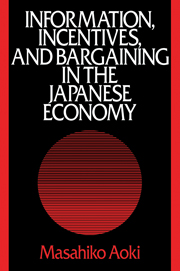 Information, Incentives and Bargaining in the Japanese Economy
Information, Incentives and Bargaining in the Japanese Economy Published online by Cambridge University Press: 14 January 2010
The preceding chapters have shown that an isomorphic structural pattern occurs at various levels of Japanese organizations: the workshop, as composed of the J-firm, the production department, and R&D department, and the government bureaucracy. In contrast to the hierarchical coordination prevalent in Western organizations, this structural pattern features relatively autonomous operating units connected horizontally without hierarchical control. In the normal course of affairs, the role of leadership here is to facilitate horizontal communication among operating units and to make strategic decisions in a constituent-based manner. We have seen that such a structural pattern is very effective in allowing an organization to adapt its operations to a continually changing environment in a time-efficient manner.
One problem with this structure is that radical organizational innovation and strategic reorientation requiring some constituent groups to make a sacrifice are not likely to occur endogenously unless they are brought on by a significant external shock such as would affect organizational viability. The Japanese organization may thus exhibit a tendency toward “progressive conservatism.” It is progressive in that it is capable of adapting itself to continually changing environments in a Nash-improving (consensual-building) manner, and it is conservative in that it is resistant to radical reorientation involving non-Pareto-improving change. Radical organizational innovation and strategic reorientation that forces some constituent groups to make a sacrifice would in general occur as a matter of organizational survival in response to drastic environmental shocks.
To save this book to your Kindle, first ensure [email protected] is added to your Approved Personal Document E-mail List under your Personal Document Settings on the Manage Your Content and Devices page of your Amazon account. Then enter the ‘name’ part of your Kindle email address below. Find out more about saving to your Kindle.
Note you can select to save to either the @free.kindle.com or @kindle.com variations. ‘@free.kindle.com’ emails are free but can only be saved to your device when it is connected to wi-fi. ‘@kindle.com’ emails can be delivered even when you are not connected to wi-fi, but note that service fees apply.
Find out more about the Kindle Personal Document Service.
To save content items to your account, please confirm that you agree to abide by our usage policies. If this is the first time you use this feature, you will be asked to authorise Cambridge Core to connect with your account. Find out more about saving content to Dropbox.
To save content items to your account, please confirm that you agree to abide by our usage policies. If this is the first time you use this feature, you will be asked to authorise Cambridge Core to connect with your account. Find out more about saving content to Google Drive.